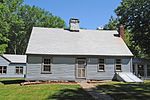Usquepaug Road Historic District
Historic districts in Washington County, Rhode IslandHistoric districts on the National Register of Historic Places in Rhode IslandNRHP infobox with nocatSouth Kingstown, Rhode IslandUse mdy dates from August 2023 ... and 1 more
Washington County, Rhode Island Registered Historic Place stubs

The Usquepaug Road Historic District is a historic district near the village of Usquepaug in South Kingstown, Rhode Island. It consists of a collection of properties, mostly on the south side of Usequepaug Road (Rhode Island Route 138) between the Usquepaug Cemetery and Dugway Bridge Road. Although the area began as a rural, agricultural area, it developed into a modest rural village, with a church, school, and cluster of vernacular rural houses. The schoolhouse was destroyed in the New England Hurricane of 1938.The district was listed on the National Register of Historic Places in 1987.
Excerpt from the Wikipedia article Usquepaug Road Historic District (License: CC BY-SA 3.0, Authors, Images).Usquepaug Road Historic District
Usquepaugh Road,
Geographical coordinates (GPS) Address Nearby Places Show on map
Geographical coordinates (GPS)
| Latitude | Longitude |
|---|---|
| N 41.503888888889 ° | E -71.600277777778 ° |
Address
Usquepaugh Road 924
02892
Rhode Island, United States
Open on Google Maps









